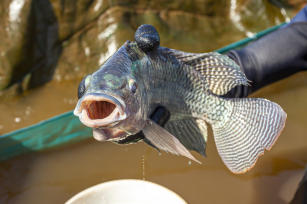Poultry liver-based supplement strengthens cellular defense in tilapia
Poultry liver-based supplement strengthens cellular defense in tilapia
Photo: Jefferson Christofoletti

Use of the additive increases cellular defense of fish under intensive systems, which may improve fish health and reduce production costs.
A recent study carried out by researchers from Federal University of Viçosa and Embrapa found that the use of food additives based on poultry liver protein hydrolysates may improve the health of tilapias under intensive production. It has a great scientific and economic importance, since Brazil, a huge chicken producer, has a great amount of raw material to synthesize protein hydrolysates.
When testing the use of hydrolysates in tilapia’s feeding, researchers detected a reduction in the formation of protein carbonyls in the fish gills. The presence of protein carbonyls normally indicates that the cells of living beings have been damaged. Protein carbonyl levels work as biomarkers of oxidative damage to proteins.
Fish fed with poultry liver protein hydrolysates presented lower levels of protein carbonyl, indicating that the additive was preventing and reducing cellular damage and, consequently, avoiding the animals’ death. Oxidative imbalance might cause reduction of feed consumption, lower growth rate, impairment of the defense system activity, and various diseases, Juliana Gomes, from the Laboratory of Applied Physiology to Pisciculture/Federal University of Viçosa (UFV), explains
Damages in fish cells are common, because when raised under intensive conditions in ponds, they go through stressful situations, such as during the classification, when they are exposed to the air and diminish their oxygen uptake through gills, as professor Jener Zuanon, from the Department of Animal Biology of UFV, explains.
According to Zuanon, stressful situations cause various metabolic disorders. An exemple is the production of reactive oxygen species, which release free radicals that damage cells. The same happens to human beings when stressed.
Hamilton Hisano, researcher at Embrapa Environment, highlights that the use of food additives can be an effective strategy to help protect fish from stress. “Food additives are strategies used to increase the consumption of feed, efficient use of nutrients, and stress tolerance under intensive management”, Hisano explains. Understanding this allows the creation of innovative nutritional strategies to optimize fish health and productivity.
Protein hydrolysates, the additives evaluated in the study, can improve the fish capacity to tolerate and recover from the management effects when they are exposed to the air. This ingredient is often used to substitute fish flour, but it has also been considered as an additive due to its capacity of modulating physiological processes.
The research also highlights the economic importance of the additives, since fish diet represents up to 70% of the total production costs. Substituting ingredients traditionally used by cheaper ones, such as the plant-based ingredients, might be an efficient way to reduce costs.
Moreover, the research calls attention to the fact that Brazil, as one of the biggest producers of chicken in the world, has a vast range of raw material to the production of protein hydrolysates. Poultry guts, such as liver, represent about 37% of the animal’s live weight, which makes this byproduct a sustainable and economic alternative to produce additives, Gomes highlights.
Fabiana Dieterich, from Falbom Agroindustrial Ltda., reinforces the importance of the research. “This kind of knowledge generated by research evidences that the interaction between public research institutions and the industry might contribute to solve problems of the productive chain”, she states.
This study is part of a partnership stablished between the Federal University of Viçosa and Embrapa Environment on additives. It is also part of the BRS Aqua project, which investigates different aspects of aquaculture, including tilapia, tambaqui, bijupirá, and saltwater shrimp. The project was financed by the Brazilian Development Bank (BNDS), Special Secretariat (SEAP), Ministry of Fisheries and Aquaculture (MPA) and Embrapa.
The full scientific article, published by Animal Feed Science and Technology, can be accessed here.
Cristina Tordin (MTb 28.499/SP)
Embrapa Environment
Press inquiries
meio-ambiente.imprensa@embrapa.br
Phone number: +55 19 99262-6751
Marcos Vicente (MTb 19027/MG)
Embrapa Environment
Press inquiries
meio-ambiente.imprensa@embrapa.br
Phone number: +55 19 3311 2611
Translation: Ana Maranhão
Superintendency of Communications
Further information on the topic
Citizen Attention Service (SAC)
www.embrapa.br/contact-us/sac/

